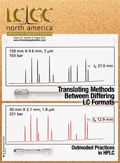Modern Mass Spectrometry in Protein Analysis
LCGC North America
An overview of the analytical approaches used for the analysis of biomolecules
It has been 25 years since electrospray ionization was shown to lead to multiple charging of peptides and proteins, effectively bringing these large biomolecules into the measurable range of the common mass analyzing devices.
In modern times, mass spectrometry (MS) is widely used in the characterization of proteins at the intact (native) and peptide levels, as well as in the analysis of enzymatically generated protein fragments, in conjunction with an expanding range of compatible chromatographic separation techniques.
Electrospray ionization of intact proteins generates a charged envelope of peaks corresponding to differing degrees of ionization that can readily be converted to the molecular mass using a mathematical algorithm. Typically, average mass is calculated; however, high mass accuracy time-of-flight and Fourier transform instruments allow isotopic resolution, which can be important in the study of protein fragments to determine sequence and post-translational modifications (PTMs). This has become known as "top down" proteomics, as the measurements are made on the intact proteins instead of enzymatically digested proteins. These methods require special ionization techniques such as electron-capture dissociation (ECD) or electron-transfer dissociation (ETD), which typically maintain the labile modifications (glycosolation for example) on the protein backbone.
The ability to differentiate certain PTMs in analyses such as glycan characterization and the level of C-terminal lysine of monoclonal antibodies is important in assessing safety and efficacy of physiologically active proteins. However, MS analysis of intact proteins with multiple glycosolation sites, occupied by various different glycans, often results in highly complex charge distributions that are very difficult or impossible to deconvolute or interpret — in these cases, cleavage of the protein or glycan residues using specific enzymatic reagents is required. PTMs such as oxidation, isomerization, or deamidation result in very small or no differences in mass, which are impossible to resolve and deconvolute within the complex charge envelope and related adduct peaks. Under these conditions, various modes of chromatography are used to chemically (reversed-phase chromatography, hydrophilic-interaction chromatography [HILIC]), hydrodynamically (size-exclusion chromatography [SEC]), or electrostatically (ion-exchange chromatography), resolve the species before mass measurement. Although the eluent systems associated with ion-exchange and size-exclusion chromatography have not traditionally been well suited to atmospheric-pressure ionization techniques, advances in these chromatographic modes, as well as the design of the MS interfaces, have made direct on-line coupling possible.
Intact protein measurements often use enzymatic, organic, or acidic conditions to denature the protein, exposing a large number of basic residues that are then ionized to form multiply charged species, ideally suited for electrospray MS. When measurements are required on the intact (or even native) protein, volatile neutral aqueous buffers are used in conjunction with mass analyzing devices with a wider mass range (typically time-of-flight instruments) as the proteins acquire a lower number of charges, and therefore have a higher mass-to-charge ratio. Native liquid chromatography–mass spectrometry (LC–MS) measurements can be made to determine protein aggregation following both on-line and off-line SEC, and ion mobility spectrometry can be particularly useful in this type of analysis. Hydrogen-deuterium (H-D) exchange techniques (the degree of deuteration for various amino acid residues within the native protein) have been used to identify exposed and nonexposed protein backbone amide hydrogens, and such peptide mapping experiments performed after H-D exchange can be used to model higher order structures of the native protein.
At the peptide level, most proteomics and peptide mapping is carried out on enzymatically digested species with the multiply charged fragments being analyzed by electrospray MS. Using high-resolution mass spectrometers combined with high efficiency high performance liquid chromatography (HPLC) systems and reversed-phase HPLC columns (sub-2-µm, core–shell particle morphologies, and packed capillary columns), determination of monoisotopic mass (to 5 ppm mass accuracy) of the fragments can lead to >98% sequence coverage, which results in unambiguous protein identification. Useful protein sequencing is still carried out using tryptic digests and lower resolution (typically quadrupole) MS-MS instruments on a daily basis with highly satisfactory results, as the ability to fragment the peptide species leads to increased confidence in the peptide identity.
LC–MS peptide mapping can also be used to reveal modifications and the site of modification and quantitative studies can be carried out by comparing peak areas from the native and modified peptides.
The judicious use of various enzymes that lead to site-specific cleavage combined with the use of derivatizing reagents and enrichment techniques can significantly enhance the specificity of information gained from LC–MS analysis in terms of the PTMs that can be identified and quantified as well as the degree of sequence coverage.

Biopharmaceutical Characterization in the Age of Artificial Intelligence
May 13th 2025AI-powered tools are enhancing precision, efficiency, and decision-making in biopharmaceutical development. Recently, Jared Auclair and Anurag Rathore explored AI's evolving role in biopharmaceuticals in detail.
Accelerating Monoclonal Antibody Quality Control: The Role of LC–MS in Upstream Bioprocessing
This study highlights the promising potential of LC–MS as a powerful tool for mAb quality control within the context of upstream processing.

.png&w=3840&q=75)

.png&w=3840&q=75)



.png&w=3840&q=75)



.png&w=3840&q=75)











